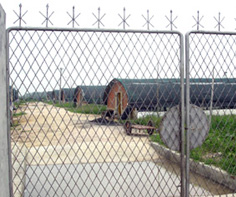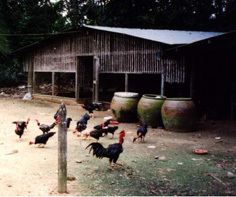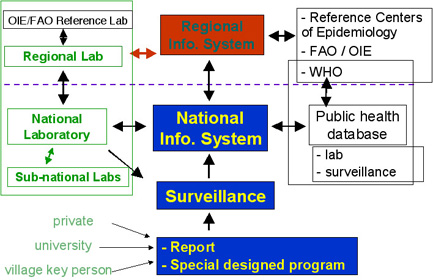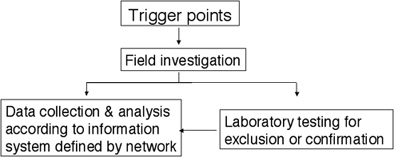Regional Networks and Guiding Principles for Highly Pathogenic Avian Influenza Surveillance and Diagnosis in Asia
FAO Regional Office for Asia and The Pacific, Bangkok
|
| Background
Guiding Principles were developed:
- During the FAO Expert Meeting (21-23 July)
- Under recognized constraints and areas of uncertainty
+ differences in biosecurity & risk between farming systems/compartments
+ different trade patterns, practices and cultural approach
+ varying surveillance & laboratory capacity
+ differences in approach for countries where infection is endemic compared
with those that are free or stamping out a limited incursion.
Guiding Principles for HPAI Surveillance and Diagnostic Networks in Asia:
- Introduction and Background
- Objectives of Surveillance & Diagnostic networks
- Minimum requirements for Surveillance systems
- Annexes:
+ surveillance methods;
+ diagnostics procedures and networks;
+ information systems
|
| Introduction and background
Surveillance (and control) strategies should be adjusted to take into account the different levels of biosecurity in farming sectors and the different levels of challenge:
+ Poultry production sectors can be described according to production and
marketing systems.
Poultry production sector
- Industrial integrated system with high level biosecurity and birds/products marketed commercially
- Commercial non-integrated poultry production system; moderate to high biosecurity; birds and products marketed commercially
- Commercial poultry production system; minimum biosecurity; birds/products in live bird markets
- Village or back yard production --- no biosecurity, informal marketing system
|
 |
 |
 |
Objectives
Surveillance Strategies must be refined to meet the priorities of each country.
- To detect clinical disease and infection
- To understand epidemiology as well as economic impact to plan for effective control program
- To help define and control risks to public health
- To monitor for antigenic drift and help understand the evolution of AI viruses
- To maintain the viability of poultry production
- To demonstrate freedom from disease and infection in order to facilitate trade
- To assess the efficacy of vaccination where used
Effective Surveillance: minimum requirements
- HPAI is notifiable (legal requirement)
- System for detecting and investigating outbreaks of disease
+ in accordance with OIE guidelines
- Capability to diagnose HPAI
- Information systems
- Participation in the regional surveillance and diagnostic network
+ including the public health sector
|
Surveillance Methods
1. Minimum requirements for detection of disease
|
Trigger points for chickens in each production sector:
|
Sector 1
|
- Reduction of feed/water intake by 20 % in one day
- Daily mortality of 1 % for 2 days |
|
Sector 2
|
- Daily mortality of 1 % for 2 days |
|
Sector 3
|
- Daily mortality of 1 % for 2 days |
|
Sector 4
|
- Daily mortality of 5 % for 2 days |
|
|
|
2. Surveillance in uninfected countries/compartments
Countries/compartments free from disease wanting to detect early incursions of virus
- Targeted surveillance at high risk areas including
+ Border areas
+ Domestic waterfowls
- Serological testing
- Virus isolation
+ Dead wild birds
- Investigation of unusual mortality and cloacal swab
+ Live bird markets
- Routine collection
- Dead birds
- Cage swabs
Countries/compartments free from disease at high risk of infection practising vaccination
- Monitoring for vaccine efficacy
- Detecting infection in vaccinated flocks
+ Sector 1 & 2: Sentinel birds
+ Sector 3: Daily mortality exceeds 1% for 2 days
+ Sector 4: Daily mortality exceeds 5% for 2 days
- Serological tests to differentiate vaccinated from infected animals
|
3. Surveillance in previously infected countries/compartments
Countries/compartments previously infected wishing to demonstrate freedom
- Dossier would be built over a period and contain information:
+ Details of biosecurity measures
+ Details of surveillance: plan and information
+ Data collection and management systems
+ Structure and activities of veterinary services
+ Legal provisions for compulsory notification
4. Surveillance in infected countries/compartments
Infected countries/compartments not practising vaccination
- Targeted surveillance at high risk areas including
+ Domestic waterfowls
- Serological testing
- Virus isolation
+ Dead wild birds
- Investigation of unusual mortality and cloacal swab
+ Live bird markets
- Routine collection
- Dead birds
- Cage swabs
+ Sector 4: pilot studies using sentinel villages
Endemically infected countries/compartments practising vaccination
- Monitoring for vaccine efficacy: serology
- Detecting infection in vaccinated flock
- Targeted surveillance at high risk areas including
+ Domestic waterfowls
+ Dead wild birds
+ Live bird markets
+ Sector 4: pilot studies using sentinel villages
|
Laboratory Procedures and Networks
1. Diagnostic Procedures
- Initial Screening Tests
+ Rapid direct antigen tests
+ Immunofluorescence tests
- Confirmatory Tests
+ Virus isolation
+ Gene sequence detection
- Procedures for characterisation of isolates
+ Haemagglutinin typing
+ Neuranimidase typing
+ Gene sequence detection and analysis
+ Live bird challenges
- Intraveneous pathogenicity index (IVPI) to classify HPAI VS LPAI
2. Serological assays
- To detect
+ Circulation of virus
+ Antibody responses to vaccination
- Haemagglutination Inhibition Test
- Agar Gel Immunodiffusion Test
- Competitive ELISA Using Group Antigen
- DIVA (Differentiating Infected from Vaccinated Animals) System
+ Antibody detection using immunofluorescence
+ Antibody detection using inhibition of neuraminidase
3. Establishment of Laboratory Networks
- Standard operating procedures (SOPs)
+ Technical aspects of diagnostic testing (OIE Manual)
+ Safety procedures for operators at different levels (WHO guidelines)
- Virus isolation can be carried out at BSL2 but handling of H5 virus should follow
enhanced safety practices recommended by WHO
+ Contamination control measures for laboratories providing molecular diagnostic services
- Flow of samples in a laboratory network
+ Sub-National Laboratory
+ National Laboratory
+ Regional Network Laboratory
+ OIE/FAO Reference Laboratory
- Quality assurance and proficiency testing
- Safe transport and handling specimens
|
Network of Laboratory and Surveillance
|
Next steps
Short term:
- Implementation of FAO sub-regional TCPs
SE Asia, East Asia and South Asia
Medium - Long term:
- According to lessons learned from SEAFMD campaign, in the future the Regional Networks for Avian Influenza can be coordinated and implemented under:
Regional initiatives, For example, ASEAN Sectoral Working Group on Livestock (ASWGL)
GF-TADs initiative
|






